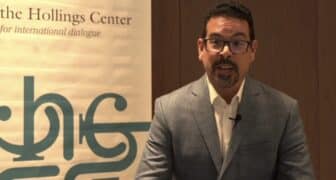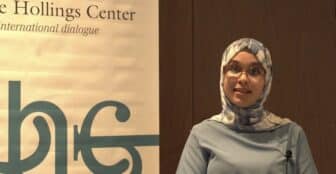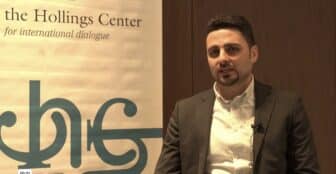Great Games, Local Rules: The New Great Power Contest in Central Asia
Alexander Cooley
Review and author interview by George Gavrilis, Executive Director of the Hollings Center
Please click here for a printer-friendly PDF version of this page.
The drive from central Dushanbe—Tajikistan’s capital—to the Afghan border is an easy four-hour jaunt. On the way, one drives past Chinese high-rise construction projects, Russian radar installations, the airport whose runway has been resurfaced by the French military and along stretches of rural highway built by the Turks and the Japanese. At the Afghan border is a massive customs facility and bridge built by U.S. taxpayer dollars. Back in Dushanbe at a popular Chinese restaurant, it is possible to dine next to tables of Iranian traders, Chinese construction supervisors, Russian FSB teams and American diplomats. Taken superficially, these scenes can give the impression that Central Asia is an arena for competition from stronger and greater powers near and far—an updated Great Game.
Refreshingly, Cooley’s book departs from impressionistic foreign policy narratives that pit the US, Russia and China in a zero-sum competition for influence in Central Asia. Instead, Great Games, Local Rules presents a sophisticated two-step argument about foreign policy and domestic politics. On foreign policy, Cooley argues that Russia, China and the United States sometimes compete with one another but more often grudgingly coexist, avoid stepping on each other’s toes and even mimic each other’s policies.
The book devotes a good deal of attention to the Shanghai Cooperation Organization (SCO), whose membership includes China, Russia and four Central Asian republics. Although American and European policymakers have worried for years that the SCO will muscle them out of the region, Cooley shows that the SCO is far from a cohesive organization. For example, Russia wants an ever-expanding SCO that dilutes China’s imprint on the organization; China wants a compact SCO that promotes Beijing’s foreign policy interests in the region; Kyrgyzstan desires an SCO that shores up its sovereignty and keeps potential threats from neighbors at bay. Based on the author’s numerous interviews with policymakers and experts in Russia, China, Central Asia and elsewhere, the discussion of the SCO should go a long way towards moderating speculation on what the organization does and doesn’t do.
A substantial portion of the book is devoted to a discussion of domestic political antics in Central Asia as they relate to foreign policy. Cooley argues that the Central Asian governments have become adept at manipulating outside powers and playing them off against each other, leveraging external engagement and aid to prop up their political fortunes. The book is chock full of good examples of Central Asian governments drawing up their own “local rules” in dealing with Moscow, Beijing and Washington. Cooley discusses the case of the Manas Transit Center in Kyrgyzstan, which the United States rents in order to fuel missions and send troops to Afghanistan:
President Bakiyev and his ruling circle actively drummed up a bidding war between Moscow and Washington, making increasingly brazen demands for economic pay-offs. This bidding war provided Bishkek with non-transparent revenues that fed elite predation, eroded institutional capacity, and limited Western actors’ willingness to criticize deteriorating political and economic trends in the country (116-117).
Government bling in Astana, Kazakhstan. Photo by George Gavrilis
The book also discusses the international corruption scandal known as Kazakhgate and the Giffen Affair as well as the less-known alleged kickbacks to Central Asian officials by Chinese energy companies eager to lock up the region’s gas and oil deposits. While foreign governments and transnational corporations routed payoffs to Central Asian officials through offshore vehicles and murky companies, seeing it as part of the cost of doing business in the region, they nonetheless found themselves frustrated by the growing assertiveness of Central Asian governments and the continuing obstacles they faced in the region.
According to Cooley, “the most skillful handler of these competing foreign powers has been Kazakhstan, which under the helm of President Nursultan Nazarbayev, has gone to great lengths to present itself as the geopolitical crossroads of multiple identities and influences, invoking the often-quoted slogan that ‘happiness is multiple pipelines’” (9).
The book should appeal to a variety of audiences beyond Central Asian specialists. It makes edifying reading for students of international relations and comparative politics but also for the think-tank community and policymakers in the United States, Eurasia and China. It should also be priority reading for anyone whose interests or work include Afghanistan. Even with the draw down of international troops in Afghanistan, the United States will continue to look for erstwhile partners in the neighborhood to keep Afghanistan afloat.
Alexander Cooley teaches political science at Barnard College and Columbia University, writes frequently on foreign policy issues and serves on the advisory board of the Open Society Foundation’s Central Eurasia Project and the external advisory committee of Human Rights Watch. He recently attended the Hollings Center’s Regional Policy Dialogue in Istanbul, Foreign Policy and Competing Mediation in the Middle East and Central Asia.
George Gavrilis sat down with Cooley to discuss Great Games, Local Rules.
Kyrgyz nationalism flying high. Photo by George Gavrilis
Gavrilis: You did quite a bit of field research in half a dozen countries for the book. What were some of the frustrations and highlights you experienced?
Cooley: Well, I think many of the frustrations were also bizarre highlights and were certainly educational. Several come to mind: One was meeting with Bakiyev’s National Security Council and base negotiating team in Bishkek. I was expecting to interview them about Kyrgyzstan’s position on the Manas basing deals and related negotiations, but instead they aggressively grilled me on why Peace Corp and USAID programs were considered U.S. aid, and they insisted that these programs should not have been part of the $150 million basing rights package in 2006—“cash only please!” On the basing issue in general, hardly anyone I met thought I could possibly have a purely academic interest on the topic.
But there were other highlights: lecturing about the importance of external actors and international rankings and perceptions to a group of Turkmen civil servants at the Presidential Academy of Management and then fielding their questions about the implosion of the U.S. financial system and the decline of U.S. credibility on international economic matters. That was a nice twist. Closer to home, I was stunned by the nasty tone of an E.U. debate that I sat in on in Brussels about lifting sanctions on Uzbekistan, with NGOs and E.U. officials debating whether the EU was a strategic or normative actor. At that point it hit me that Central Asia has done its own share to influence the identities and politics of the actors allegedly influencing it.
Perhaps my biggest fascination (and frustration) was becoming more immersed in the Chinese dimension over the last 4 years. I’ve seen considerable evolution and growing sophistication on the part of Chinese experts and policymakers, yet my lack of language skills has prevented me from gaining a more nuanced appreciation of what is going on. But in general, contrasting the diplomatic styles of China and Russia in the region– one low key, always downplaying its role versus the other overtly trumpeting its long-held ties, backroom deals and soft power– has been as instructive as it is entertaining.
Gavrilis: Colloquially speaking, it seems that your book’s message to policymakers in DC is, “Don’t worry so much about Moscow or Beijing, worry about getting played by the Central Asian republics.” Are they receptive to this message?
Map of Central Asia. Source: UT-Austin map library
Cooley: Yes, that’s definitely one of the practical messages of the book. Some policy makers definitely are receptive, but it also depends on specific bureaucratic pressures and the issue in question. Everyone has priorities and trains need to run on time. But the Central Asian states themselves do a good job of masking their own agency by invoking alleged external pressures from Beijing and Moscow. This makes it tempting for Western officials to offer security cooperation and economic benefits, while toning down the other aspects of engagement, such as the values agenda, human rights and civil society promotion.
But, as I write in the Conclusion, this challenge of dealing with the agency of small states in multipolar settings presents a far broader challenge to U.S. foreign policymakers than just what has been happening in Central Asia. For example, the post-Arab Spring Middle East is an area where despite continuing U.S. engagement and significant allocations of aid, security assistance and civil society programming, actual U.S. influence appears to be diminishing while other external players are also getting involved.
Gavrilis: Are the Chinese frustrated about corruption in Central Asia or do they see it as a necessary and palatable cost?
Cooley: Well, there is certainly frustration, but different Chinese actors have different thresholds of tolerance, something I don’t do a good enough job of caveating in the book. The small and medium-sized business community has grown frustrated at some of these whimsical border policies and regulatory changes imposed by Central Asian governments, as are Chinese planners who had hoped to turn the SCO into a more institutionalized legal framework for rationalizing regional trade and investment. There is also a generation of younger Chinese scholars and analysts that view Central Asia as ripe for implementing new technologies and arrangements to streamline transactions and settle regional payments. Of course, Chinese energy companies like CNPC have considerable experience working in overseas environments with challenging governance issues—they seem to be handling their Central Asian deals just fine.
Gavrilis: What would Central Asia look like without U.S. development or military assistance?
Cooley: That’s an almost impossible counterfactual to consider, as both Western security and development assistance have triggered Russian and Chinese responses and counter-initiatives—so it’s tough to disentangle the independent effects of any one outside country’s engagement. It’s been the interaction of U.S. involvement with other external powers that has empowered local sovereigns to use external resources for their own private political and economic benefit. For example, Bakiyev extracted funds from Moscow in 2009 to supposedly close Manas and then routed them to offshore bank accounts. Also, formal U.S. aid in the region is actually not all that big, but it is accompanied by a range of contractors, third party deals and commercial arrangements that support the U.S. military logistics effort.
There is also an incentive on behalf of the governments of the smaller states to characterize themselves as “fragile” or in danger of failure, in order to extract more economic and security assistance from the international community. In this context, many Western initiatives are well intentioned but end up backfiring when implemented or brokered by Central Asian elites. For example, I think that the latest “New Silk Route” initiative risks heightening competition over individual projects, rather than actually fostering regional integration. One of the central themes of the book is that different external efforts to promote regional integration have done little to reduce informal barriers to trade and have reified the role of borders in Central Asia.





